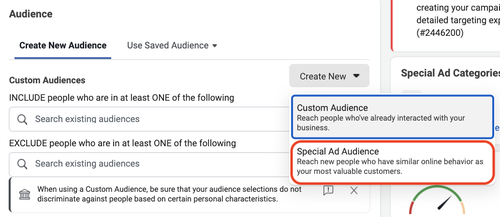The new Facebook Special Ads Category Restrictions: What You Need To Know
For those of us in the world of digital marketing, the Special Ads category restrictions Facebook put into effect last week certainly got our attention.
The Backstory
On March 19, 2019 Facebook announced that changes were on the way for advertisers targetting audiences in the housing, credit employment and political issues categories in the pursuit to protect against discrimination based on age, gender, postal code and interests.
This change was the result of multiple lawsuits by the National Fair Housing Alliance (NFHA), the American Civil Liberties Union (ACLU), and the Communication Workers of America (CWA), forcing Facebook to review its ads tools and implement changes to guard against misuse.
The Changes Made
Facebook officially put these changes into effect on December 3rd last week. This is the official Facebook Announcement:
Anyone who wants to run housing, employment or credit ads will no longer be allowed to target by age, gender or zip code.
Advertisers offering housing, employment and credit opportunities will have a much smaller set of targeting categories to use in their campaigns overall. Multicultural affinity targeting will continue to be unavailable for these ads. Additionally, any detailed targeting option describing or appearing to relate to protected classes will also be unavailable.
What Industries Were Affected, and How?
In a nutshell, advertisers in the housing, employment and credit industries can no longer segment by:
Age
Gender
Exclude Postal Codes
Certain Interests
The use of Lookalike Audiences was also affected, as they are no longer allowed. They have been replaced for the “Special Ad Category” audience that uses uploaded customer lists by finding people with similar online behaviour, without discriminating based on age, gender, postal code and interests.
One last change that wasn’t announced but we noticed on December 3rd is that ‘Detailed Targeting Expansion’ is no longer available, effectively reducing the size of your audience.
All ads and campaigns referring to those categories and that didn’t clearly indicate they belonged to a Special Ad Category were automatically rejected, leaving us all in a mad panic.
How Do We Deal With This Change?
If you’re in one of the affected industries, here’s what can you do to comply with the new anti-discriminatory policies:
Review your current campaigns in the categories mentioned above.
Make sure you select the “I'm creating a campaign for ads in a Special Ad Category” at the campaign level.
Modify your targeting to include all ages 18+, all genders, choose a minimum targeting radius of 15 miles, do not exclude any geographical areas, and turn off detailed targeting expansion.
Replace your Lookalike audiences for Special Ad Category audience and change your ad set name.
Replace your Lookalike Audiences!
Don’t forget to replace your ‘Lookalike’ audiences with ‘Special Audience Ad’ and let the algorithm do its job! The best part of having AI as part of the Facebook advertising platform is that it will eventually find people most likely to complete the action you are optimizing (traffic / leads / etc). So be patient and let the algorithm learn and do its job!
Get Creative!
Do you still want to segment your leads by age group?
You can do so with smart questions on your landing page.
For example, you can include questions in your website form like:
Are you a first time home buyer?
Are you an investor?
Are you looking for a new mortgage?
Are you looking to refinance your current mortgage?
Are you looking for a mortgage renewal?
Test, test and test!
Now more than ever, it’s extremely important to test your copy, images, call to actions and everything you can think of! This can really make the difference between having a successful campaign or a mediocre one.
Don’t Forget about Google Ads!
We’ve seen great results with well structured, hyper-targeted Google Ads Campaigns! Cost tends to be a bit higher compared with Facebook Ads, but so is intent to buy, so make sure to include it in your marketing strategy if it makes sense!
Written by Darian Kovacs, host of the Marketing News Canada News Show and founder of Jelly Digital Marketing and PR.




